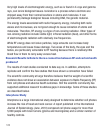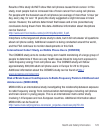
124
Surveillance, Epidemiology, and End Results (SEER) Program of the National
Cancer Institute
The National Cancer Institute (NCI) actively follows cancer statistics in the United
States to detect any change in rates of new cases for brain cancer. If cell phones
play a role in risk for brain cancer, rates should go up, because heavy cell phone
use has been common for quite some time in the U.S. Between 1987 and 2005, the
overall age-adjusted incidence of brain cancer did not increase. Additional
information about SEER can be found at
http://seer.cancer.gov/
.
Cell Phone Industry Actions
Although the existing scientific data do not justify FDA regulatory actions, the FDA
has urged the cell phone industry to take a number of steps, including the following:
•
Support-needed research on possible biological effects of RF for the type of signal emitted
by cell phones;
•
Design cell phones in a way that minimizes any RF exposure to the user; and
•
Cooperate in providing users of cell phones with the current information on cell phone use
and human health concerns.
The FDA also is working with voluntary standard-setting bodies such as the Institute
of Electrical and Electronics Engineers (IEEE), the International Commission on
Non-Ionizing Radiation Protection (ICNIRP), and others to assure that safety
standards continue to adequately protect the public.
Reducing Exposure: Hands-Free Kits and Other Accessories
Steps to Reduce Exposure to Radio Frequency Energy
If there is a risk from being exposed to radio frequency energy (RF) from cell phones
- and at this point we do not know that there is - it is probably very small. But, if you
are concerned about avoiding even potential risks, you can take a few simple steps
to minimize your RF exposure.
•
Reduce the amount of time spent using your cell phone;


















